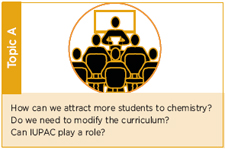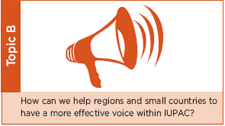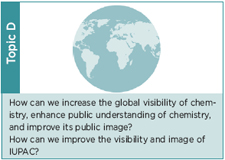|
|
Vol.
29 No. 3
May-June 2007
| Up
for Discussion |
|
|
A
forum for members and member organizations to share ideas
and concerns.
Send your comments by e-mail to [email protected] |
IUPAC
Council Round Table Discussions
For
the first time, four round table discussions will he held
during the 2007 General Assembly. This will allow small groups
of Council delegates to discuss subjects of mutual interest
in a setting conducive to the easy exchange of ideas.
Each
round table will be limited to no more than 40 participants.
When registering for the Council, delegates interested in
participating in a discussion will be asked to prioritize
their interest in the discussion topics. Assignments to the
various round tables will be based as much as possible on
these priority interests. In each case, two members of the
Bureau will chair and mediate the discussion.
In this article, each topic is presented in some detail by
the named chair and moderator, allowing them to set the stage
for later discussions.
The actual sessions will take place on the morning of Friday
10 August. Registration is required. Participation is restricted
to delegates attending the Council. Contact your National
Adhering Organization or the IUPAC Secretariat for more information.

Chair:
Maria C.E. van Dam-Mieras (Netherlands)
Moderator:
David StC. Black (Australia)
This
question raises many issues. In general terms the attraction
of students to chemistry, both as a course of study and a
potential profession, depends on many interconnecting influences.
These include:
- community
appreciation of the intrinsic value of chemistry in daily
life
-
community understanding of chemistry
-
community and government acknowledgement of the importance
of chemistry
-
community and government acknowledgement of the role of
chemistry in sustainable development
-
parental influences in determining career paths for children
-
the level of esteem held by the community for the chemistry
profession
These
general influences form an underlying social attitude. More
direct and tangible influences come from the education systems
involved at the primary and secondary level. These include:
- the
methods of introduction of chemistry to young children
-
how chemistry is taught in schools
-
the curriculum content and sequence of delivery
-
the quality of teachers
-
the difficulty of the subject
-
the ability to carry out interesting experiments
-
the ability to transfer an interest in chemistry to further
tertiary study
All
of the above influences are the nature of concern in all countries,
but their relative importance differs from country to country.
While the level of understanding of chemistry might not vary
too much from country to country, the perception of its importance
does. The major, rapidly developing countries in Asia certainly
value chemistry as an important key to future development,
while European and other Western countries have gone beyond
that stage and are more concerned with tighter regulation.
There is a link between the emphasis on regulation and a poor
community understanding—and particularly appreciation—
of chemistry. So this brings us back to the matter of education
of the public about chemistry.
The issues are also cyclical. A student wishing to become
a teacher can choose between chemistry and other science subjects
such as mathematics or biology. In many ways, given the available
classroom facilities, mathematics and biology would be easier
to deliver than chemistry. Without dedicated and stimulating
chemistry teachers, it is unlikely that students will be attracted
to further chemistry study. If students become genuinely enthusiastic
about chemistry, they frequently transfer this enthusiasm
to other areas such as the more socially esteemed field of
medicine at the tertiary level.
While medicine, and indeed biology as a whole, are becoming
more molecular in their level of understanding, the importance
of a strong chemistry background has not yet emerged in (or
in some cases returned to) the relevant medicine and biology
curricula. The fundamental chemistry curriculum needs to be
strong and well designed. In this respect it arguably needs
dramatic revision. Most curricula are designed by chemists
who know and understand the importance of chemistry, but fail
to justify this importance. A systematic approach usually
starts with the fundamentals of the subject, which are not
always seen as relevant in the eyes of students. Chemistry
teaching needs to start with the basis that we, and indeed
the entire world, are just collections of molecules. So perhaps
we should start with the molecules of nature, in other words
organic chemistry, then move to physical and general chemistry
because we need to understand what such molecules are and
how they behave. The reasons for studying chemistry need to
be made clear at the outset of the educational program—and
this means at the primary school level.
The issues of stimulating students and developing more exciting
curriculum material are already being taken up with varying
degrees of vigor by individual national chemical societies.
However, chemistry is a truly international subject that transcends
national boundaries. Globalization is a major influence in
the world today, and an unprecedented amount of material can
be accessed easily via the internet, but primary and secondary
education systems retain a largely national focus. The question
for IUPAC is “What can most effectively be done at the
international level?” IUPAC could:
- work
to increase the general public understanding of chemistry
-
work to raise the level of public appreciation of the value
of chemistry
-
play a coordinating role in linking and sharing national
strategies
-
act as a neutral nongovernmental organization (NGO) in dealing
with government agencies
-
develop generic educational material for international application
-
seek to develop truly innovative approaches to the teaching
of chemistry
-
provide publicity and promotional material for use by national
chemical societies
IUPAC
has the mechanisms through the project system to bring together
international task groups to gather and assess data, and then
to inspire novel and effective approaches to the encouragement
of young people into chemistry. There are existing projects
that address some of the above points, and these will provide
a good basis for discussion.

Chair:
Christoph F. Buxtorf (Switzerland)
Moderator:
Stanislaw Penczek (Poland)
In
many worldwide organizations and operations (e.g., the United
Nations) smaller countries feel that their voices are not
well heard amidst the discussions among big nations. In response,
many such organizations are giving smaller countries higher
visibility, proportionally more rights and votes (e.g., in
their General Assembly), and more assignments in committees
and working groups. IUPAC has already done many of these things.
Smaller countries in IUPAC’s view are National Adhering
Organizations (NAO) with a lower “chemical turnover,”
which means a smaller chemical industry. In recent years,
large companies have been searching for applied science research
opportunities in particular in countries with large populations,
sizable education systems, and a nascent chemical industry.
IUPAC’s influence could help such companies establish
better contacts.
In many ways, IUPAC has already understood the needs of smaller
countries and responded with special programs, meetings, training,
lectures, and scholarships and visiting programs, particularly
for young scientists. But is it enough and what else could
be done? There is definitely not a “one size fits all
needs” solution. A smaller country in Africa may need
different assistance than a smaller country in Asia or Eastern
Europe.
What
Can IUPAC Do?
- What
could IUPAC do to improve general chemistry education in
small countries?
-
Can IUPAC help educate the public and government authorities
in smaller countries?
-
Could IUPAC play a role as an NGO in concert with ICSU and
UNIDO?
-
Does IUPAC have a role to enable smaller countries to develop
their own research programs?
-
Is there room for less-sophisticated, lower-technology chemistry,
which could be followed by higher-technology chemistry?
-
Can IUPAC provide “first aid” via the internet
or with “flying experts, using its pools of volunteers—those
specialized in education, environmental sciences, production
safety, etc.?
-
Could IUPAC help provide better access to
chemical libraries and technical and chemical literature?
-
Should IUPAC encourage publishers to provide free access
to electronic versions of books?
-
How could IUPAC help bring industry in contact with small
countries (e.g., through an affiliated company of a large
multinational)?
What
Can A “Smaller Country” Do to Be Better Heard
and Recognized?
-
How can a smaller country explain its needs for scientific
and educational programs?
-
Could geographic regions bundle their programs and help
each other out?
-
Is there a possibility for seminars to exchange experiences
and expertise?
-
Could IUPAC create “clusters of interest” in
these geographical regions?
-
How can we ensure that smaller countries—which are
equal to any other country—take an active part in
the work of IUPAC?
Addressing
these types of questions in the round table discussion should
help us ensure that the every “citizen” in IUPAC
has a voice and an adequate platform for their issues and
concerns.

Chair:
Bryan R. Henry (Canada)
Moderator:
Nicole J. Moreau (France)
The
topic of improved interactions with other organizations could
be approached with the following sequence of questions:
1.
Do we need more interactions than we have at present? What
is their purpose?
2. The topic title lists a number
of possibilities for interaction partners. Is this list complete?
Are there any other groups we should include in our interactions?
3. What is the most effective
way to increase our interactions with each of these groups?
4. What do we expect to get out
of our interaction with each of these groups?
5. How aggressively should we
pursue formal NGO status with various bodies?
Further
elaborating on question 1, let us assume the answer is yes
and we need more interactions. Perhaps one purpose of these
increased interactions is to broaden knowledge of IUPAC’s
existence and its role. IUPAC was created in response to a
demand from chemical industry for international standards
to facilitate patents, trade, and exchanges. Thus, we have
become known for terminology, nomenclature, and critically
evaluated databases. Should we build on this reputation or
should we devote our efforts to letting the world know that
IUPAC is much more than just the above three topics? For example,
our project system involves close to 1 000 scientists worldwide,
we are active in supporting conferences, we are working with
the Organization for the Prohibition of Chemical Weapons,
and we produce a number of publications. Perhaps we should
try to build on our traditional strengths and publicize the
breadth of our operations.
Additional reasons for increased interactions might include
attracting more students to chemistry, increasing the global
visibility of chemistry, and enhancing public understanding
of chemistry. Are there others?
Thinking of questions 2, 3, and 4, let us be reminded that
the purpose of ICSU, which was founded in 1931, was to form
a coalition of scientific unions that would focus on interdispciplinary
science. It has a large number of national members (more than
100), which has produced an interesting dichotomy. ICSU has
some effective interactions with governments and international
organizations. Should IUPAC try and take more advantage of
ICSU and its governmental and international contacts to broaden
the outreach of its own activities? This might be an appropriate
time for such an initiative given that the IUPAC president
is one of eight elected members of the ICSU Executive.
In addition to working through ICSU, should we more aggressively
pursue contacts with decision makers directly through IUPAC
itself and perhaps through our national committees?
We have a number of programs that attempt to involve younger
scientists in IUPAC activities. Given the pressures on younger
scientists early in their career, is this a group that we
should try to interact with more effectively? When we attempt
to interact with governments, should we focus on the public
understanding of chemistry or should we direct our efforts
to the public appreciation of chemistry and to its benefits
to society? In interacting directly with the public, are we
better to focus on chemistry educators and national associations
and support their efforts? The fields of green chemistry and
sustainable development are both popular and crowded. Do we
have a unique contribution to make and to share with decision
makers?
With regard to question 5 and IUPAC’s NGO status, let
us not forget that through its Committee on Chemistry and
Industry (COCI), IUPAC works to include chemical industry
more actively in its activities. These efforts have involved
strengthening the Company Associates program and a number
of other initiatives. For example, we have tried to interact
more directly with industry-based organizations. IUPAC can
help industry in its attempts to bring rationale discussions
and solutions to the attention of government as they relate
to chemical problems. However, to do so effectively, we need
the cooperation and participation of chemical industry. The
Strategic Approach to International Chemicals Management is
a policy framework for international action on chemical hazards
(see feature on page 8). This is the type of organization
where COCI believes it is important for IUPAC to establish
official NGO status. We are in the process of doing so. Is
such an initiative important and should we seek additional
opportunities to associate with other bodies as an NGO?

Chair:
Peter G. Mahaffy (Canada)
Moderator:
Leiv K. Sydnes (Norway)
Increasing
the global visibility of chemistry, enhancing its public understanding,
and improving its public image can all be seen as explicit,
central elements of IUPAC’s strategy to “contribute
to the worldwide understanding and application of the chemical
sciences, to the betterment of the human condition.”
The global perspective and networks provided by IUPAC as a
worldwide scientific organization should position us well
to make a meaningful contribution in each of these areas.
But sorting out what IUPAC is best positioned to do relative
to the many other players is challenging, and we must avoid
confusion between the three important but different goals
of enhancing public understanding of chemistry, improving
its public image, and improving the visibility and image of
IUPAC.
For background, participants in this round table discussion
are strongly encouraged to read a recent report and recommendations
by the Committee on Chemistry Education (CCE) on IUPAC’s
role in achieving mutual understanding between chemists and
the public (see July 2006 CI, p.14,
and IUPAC project #2004-047-1-050 <www.iupac.org/projects/
2004/2004-047-1-050.html>).
The report suggests the following motivations for IUPAC’s
involvement in public understanding of chemistry (PUC) initiatives:
-
IUPAC wants to provide leadership to enable chemists to
address global issues that involve the molecular sciences.
-
IUPAC acknowledges that the public ultimately decides whether
and to what extent the benefits of chemistry are realized.
-
Chemists therefore need to engage with the public to create
a climate in which the potential benefits of chemistry can
be realized.
-
To create and support effective two-way communication, chemists
need to understand the needs and concerns of the public.
-
Good decision making in society depends on mutual understanding
and trust between chemists and the public.
IUPAC needs strategies to promote this mutual understanding.
Noting
that “one size fits all” messages are ineffective,
the report addresses the question: Who are the public(s) IUPAC
should be trying to reach? IUPAC can be considered to be at
the center of a set of concentric circles, each of which represents
a “public” with which IUPAC may wish to interact
in relation to the public understanding of chemistry. IUPAC
is closest to and/or can readily interact with its own adhering
bodies and national chemical societies, other multinational
organizations, and the scientific and educational arms of
national governments. It is relatively remote from most chemists,
who are members of national bodies rather than of IUPAC itself,
and very remote from teachers, students, and the general public.
IUPAC has neither the resources, nor the expertise to address
all of these “publics.” It needs to concentrate
its activities with those publics with which it is well placed
(and perhaps better placed than others), while interacting
indirectly with those publics that are more remote (and who
are better addressed by others). Primary publics for IUPAC
are those chemists who are closely associated with IUPAC,
and one of the first steps for IUPAC is to assist its chemist-members
in understanding the needs and aspirations of their target
audiences. The media and the public will see through any imbalance
or confusion of motives and will spot anything that is self-serving.
The four recommendations in the report are a good starting
point for our round table discussion about IUPAC’s role
in PUC initiatives and in enhancing the visibility and public
image of chemistry.
Recommendation 1: In keeping with
its mission to “contribute to the worldwide understanding
and application of the chemical sciences, to the betterment
of the human condition,” IUPAC has an important role
to play in enhancing public understanding of chemistry.
Recommendation
2:
Public understanding of chemistry activities aimed at supporting
teachers and students within the formal school system are
more effective than those aimed at the general public.
Recommendation
3:
IUPAC is just one of many actors in public understanding of
science, and will frequently need to work collaboratively
with the other scientific unions and other bodies. IUPAC can
not cover the full range of possible activities and address
all audiences, not least because it is remote from the general
public. IUPAC’s primary targeted public should be IUPAC
chemists and educators, and IUPAC’s most important role
is to help them understand and work with a variety of other
publics.
Recommendation
4:
We propose IUPAC’s niche as focusing on activities that
indirectly enhance public understanding, such as the following:
(a) helping scientists identify and understand their publics
(b) influencing international organizations
(c) supporting science education systems, particularly in
countries in transition
(d) supporting scientists and educators by communicating relevant
findings from IUPAC projects and activities at an appropriate
level
(e) supporting national chemical societies and other organizations
Guided
by these recommendations, we suggest the following eight questions
to focus on in our round table discussion:
1.
What is IUPAC’s motivation in increasing the global
visibility of chemistry, enhancing public understanding of
chemistry, and improving its public image? How does our motivation
as a worldwide scientific organization coincide with and how
does it differ from other players such as national chemical
societies and chemical industry?
2.
Which “publics” is IUPAC closest to, and how are
we best positioned to work with those publics to increase
the global visibility of chemistry, enhance public understanding
of chemistry, and improve its public image?
3.
Which international organizations is IUPAC best positioned
to work with to achieve these goals? (See Roundtable Topic
C)
4.
How can IUPAC best support science education systems, particularly
in countries in transition? (See Roundtable Topic A)
5.
Do we currently do a good job of highlighting the educational
dimensions of IUPAC projects, conferences, and activities.
Are they visible, intelligible, and useful to teachers and
students? How can we improve?
6.
How can we best support industrial associations, national
chemical societies, NAOs, and other organizations in achieving
these goals?
7.
What role might an International Year of Chemistry play in
achieving these goals?
8.
How might the initiatives above be carried out in such a way
as to improve the visibility and image of IUPAC?
Conclusion
It is a relatively easy task to outline the questions, but
much more difficult to provide practical answers. It is hoped
that the round table discussions will lead to some really
good suggestions and plans for future IUPAC activity.
www.iupac.org/symposia/conferences/ga07/roundtables.html
Page
last modified 15 June 2007.
Copyright © 2003-2007 International Union of Pure and
Applied Chemistry.
Questions regarding the website, please contact [email protected]
|